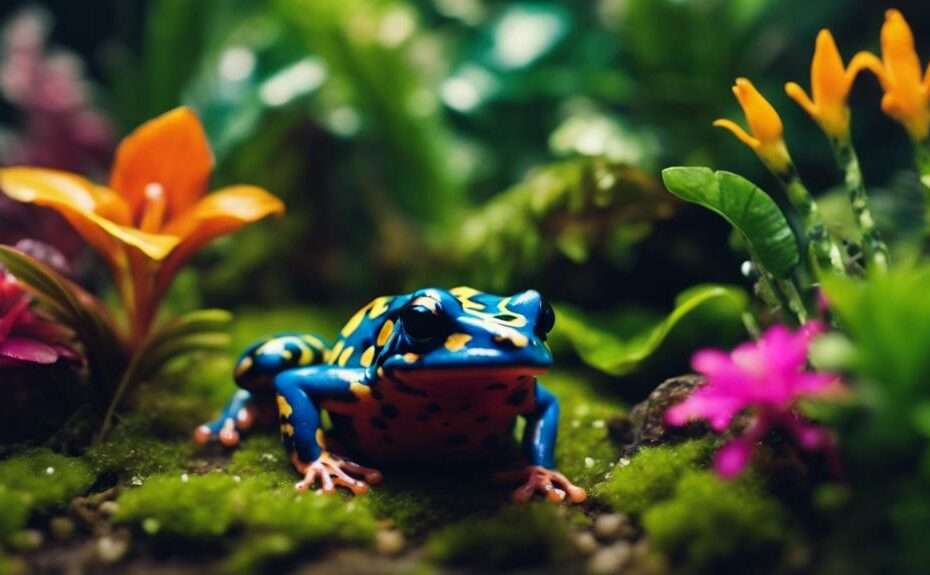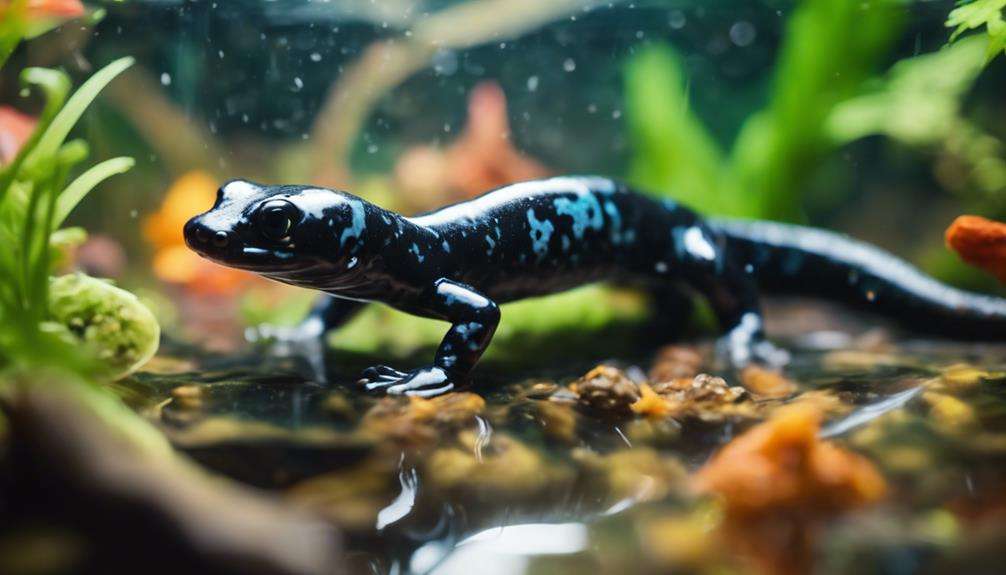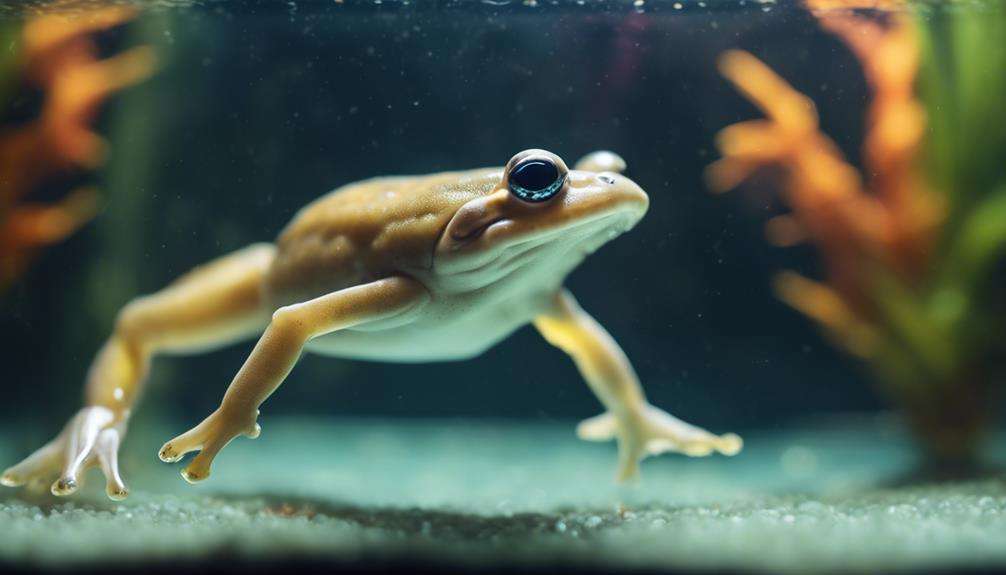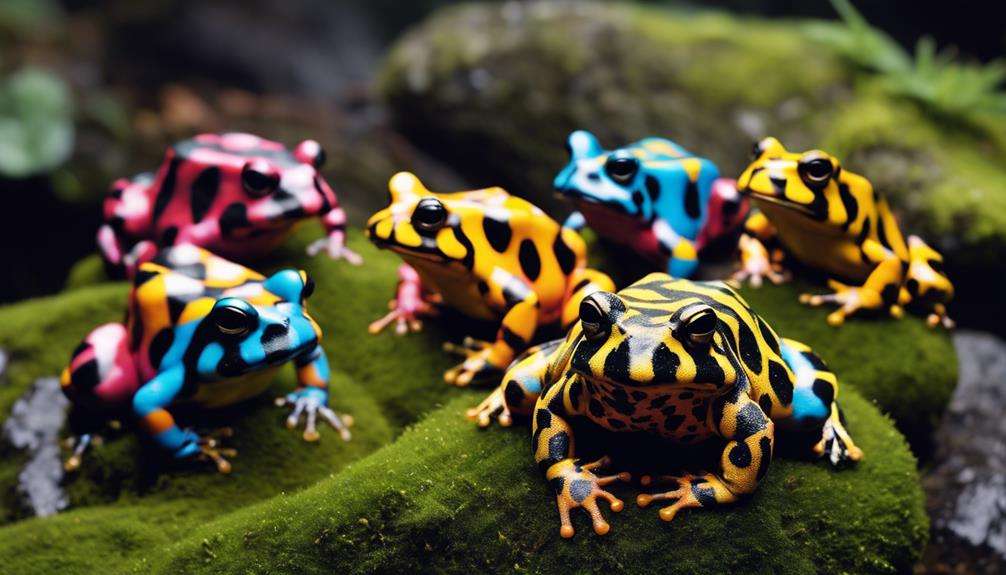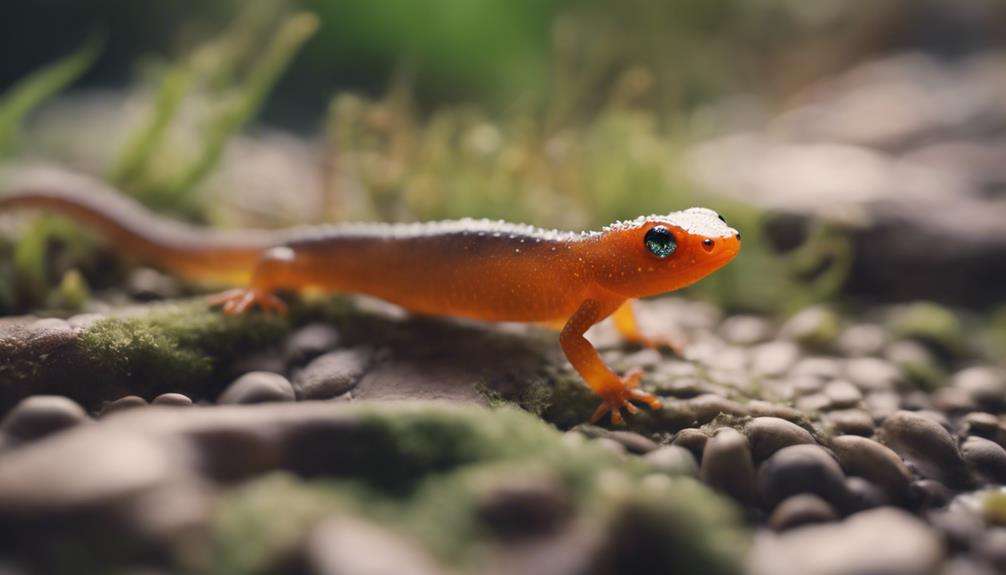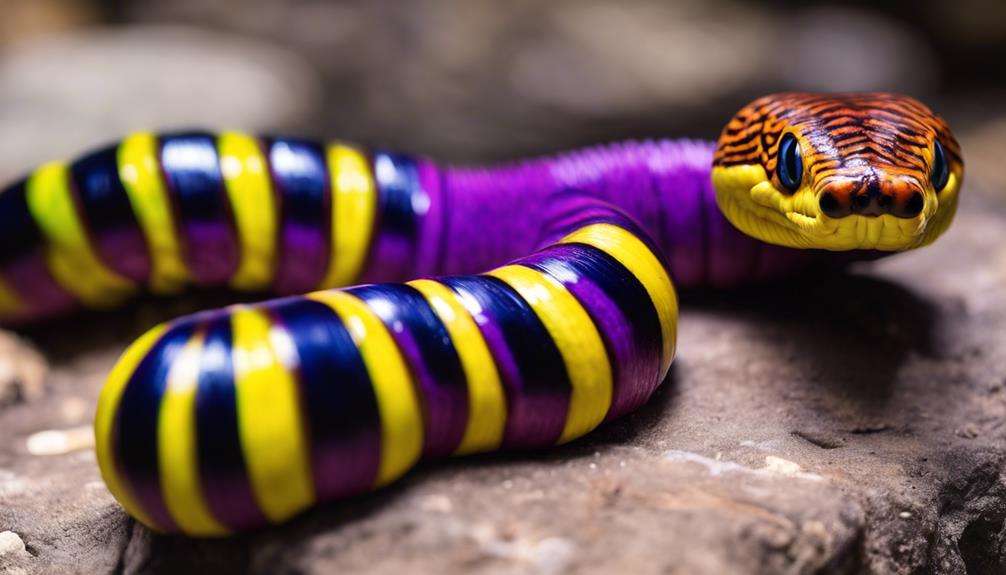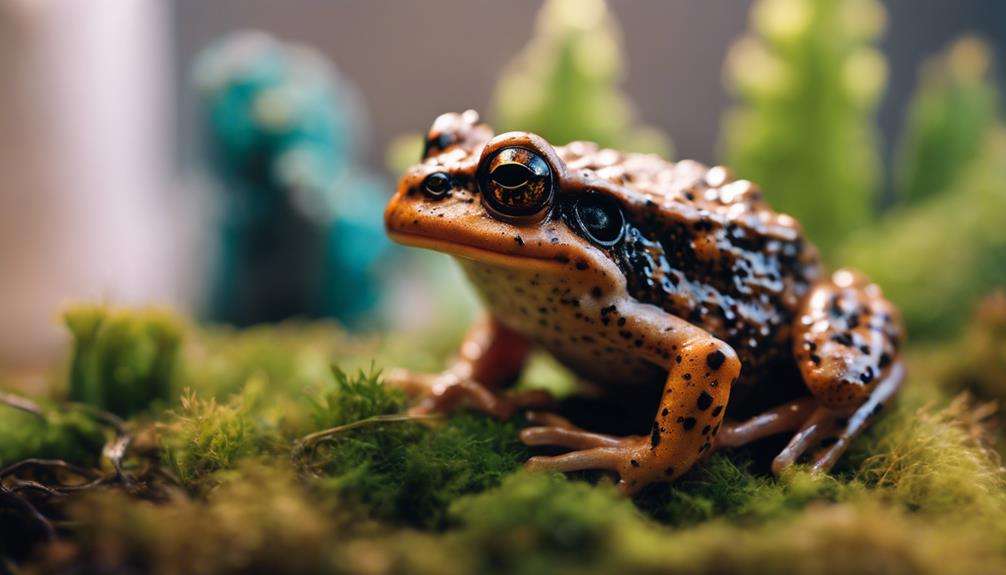Looking to inject a burst of vibrant color into your living space? Imagine having a collection of ten amphibians that not only brighten your home but also spark conversation with their stunning hues and unique features.
These colorful creatures are more than just pets; they are a captivating blend of nature's artistry and can transform your home into a lively oasis of colors.
Stay tuned to discover which of these ten amphibians will bring a touch of the wild into your everyday life.
Key Takeaways
- Poison Dart Frogs offer vibrant hues and unique behaviors for captivating displays.
- Red-Eyed Tree Frogs feature striking red eyes and green bodies, perfect for a lively terrarium.
- Mexican Dumpy Frogs, with their long lifespan and vibrant colors, add charm to any amphibian collection.
- Borneo Eared Frogs, with their distinctive appearance and arboreal preferences, bring a touch of the exotic to your home.
Blue Poison Dart Frog
The Blue Poison Dart Frog, with its striking azure hue and tiny 2-inch frame, captivates observers with its vibrant appearance and fascinating behavior. Imagine adding a vivarium to your living room, with the Blue Poison Dart Frog as the focal point. These frogs are native to Suriname and thrive in habitats rich with leaf litter, where they can forage for their insect prey. In a well-designed enclosure, the leaf litter not only mimics their natural environment but also provides hiding spots and stimulates their natural behaviors.
Observing these frogs in their habitat, you'll notice their agile movements as they navigate through the leaf litter, showcasing their hunting prowess. Their bright blue coloration serves as a warning to potential predators, signaling the toxicity of their skin secretions. Creating a miniature ecosystem in your living room with these captivating frogs introduces a touch of the exotic while allowing you to appreciate the intricate balance of nature up close.
Red-Eyed Tree Frog
With their large red eyes and vibrant green bodies highlighted by blue sides, Red-Eyed Tree Frogs stand out as nocturnal creatures inhabiting the lush rainforests of Central and South America. These stunning amphibians measure about 2-3 inches in length and possess striking red-orange feet adorned with intricate blue and yellow markings, adding a pop of contrasting colors to their overall appearance.
During the day, Red-Eyed Tree Frogs can be found sleeping on the underside of leaves, using their cryptic coloration to blend seamlessly with their surroundings and evade predators. As dusk falls, these agile hunters emerge to forage for their primary diet of insects, showcasing their remarkable jumping abilities to catch prey with precision.
The captivating beauty of the Red-Eyed Tree Frog not only lies in its vibrant hues but also in its unique behaviors and adaptations that make it a fascinating species to observe in its natural habitat. From its distinctive coloration to its nocturnal habits, these frogs bring a touch of vibrancy and mystery to the rainforest ecosystem.
Golden Poison Frog
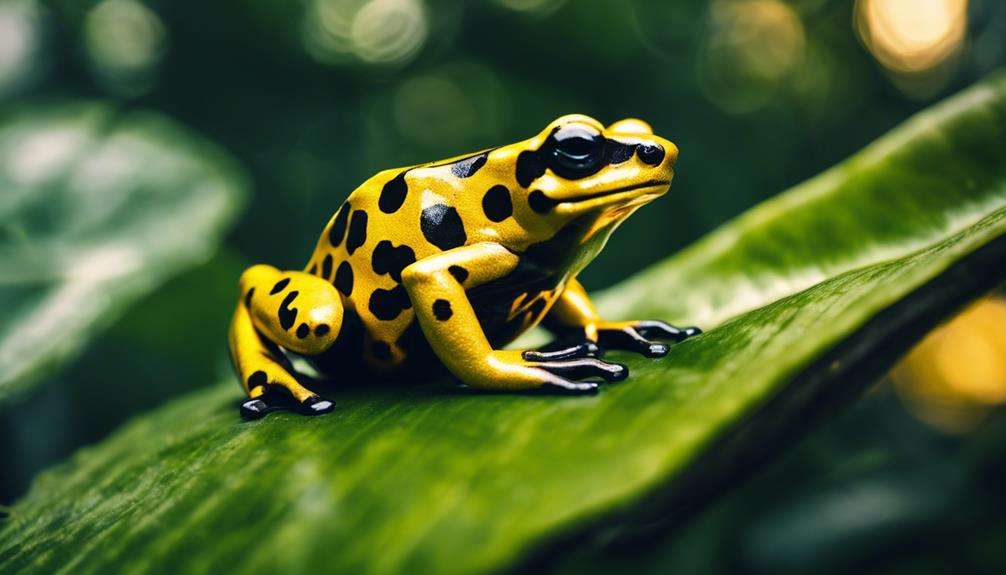
Golden Poison Frogs, known for their shiny golden skin and deadly poison, are a striking amphibian species native to Colombia. Their poisonous beauty serves as a warning to predators of the danger they possess. These frogs are considered one of the most toxic animals on Earth due to the potent alkaloid toxins they secrete through their skin.
In their rainforest habitat, Golden Poison Frogs exhibit fascinating parental care behaviors. Unlike many other frog species, males take the lead in caring for the eggs. They diligently guard the eggs, ensuring their safety until they hatch. This level of parental involvement is a unique trait among amphibians and showcases the dedication of male Golden Poison Frogs to their offspring.
Living an average of 6 to 10 years, these endangered frogs play a crucial role in the ecosystem. Their vibrant yellow to orange appearance not only adds color to the rainforest but also serves as a reminder of the delicate balance of nature.
Mimic Poison Frog
The Mimic Poison Frog, native to Peru, showcases a vibrant color combination of yellow or orange skin with blue legs and intricate black markings.
This species, while possessing a milder poison than its more toxic relatives, relies on its striking appearance to mimic the toxicity of other frogs for protection.
Colorful Patterns and Markings
Originating in Peru, the Mimic Poison Frog captivates with its vibrant yellow or orange body adorned with striking blue legs and intricate black markings. This species exhibits unique color combinations that make it stand out among other frogs. When you observe a Mimic Poison Frog up close, you can see:
- Bright yellow or orange skin that catches your eye immediately.
- Contrasting blue legs that provide a stunning pop of color against the body.
- Intricate black markings that create a mesmerizing pattern, resembling a work of art in nature.
These colorful patterns and vibrant hues serve as a natural warning sign to predators due to their resemblance to more toxic frog species, showcasing the clever adaptation of the Mimic Poison Frog.
Habitat and Behavior
With its unique habitat preferences and intriguing behavioral traits, the Mimic Poison Frog offers a fascinating glimpse into the intricacies of its natural environment.
These frogs exhibit interesting reproductive habits, laying eggs in moist areas like leaf litter or near water bodies. Their camouflage techniques, blending into their surroundings with vibrant colors, help them evade predators and attract mates.
Mimic Poison Frogs are solitary creatures, except during mating season when they engage in social interactions. Their feeding preferences include small insects, which they catch with their long, sticky tongues.
Environmental adaptation is key for these frogs, as they thrive in humid rainforest environments. To avoid predators, they rely on their mimicry of more toxic frog species, deterring threats through deceptive appearances.
Caring for Mimic Frogs
When caring for Mimic Poison Frogs, ensure their habitat replicates the humid rainforest conditions they thrive in to support their environmental adaptation. These frogs require specific care to thrive:
- Feeding habits, breeding: Mimic Poison Frogs are insectivores, feeding on small insects like fruit flies and pinhead crickets. To replicate their natural diet, provide a variety of prey. Breeding these frogs can be challenging due to specific environmental conditions required for successful reproduction.
- Handling precautions, tank setup: Due to their delicate skin, avoid handling Mimic Poison Frogs unless necessary. Set up their tank with a substrate that retains moisture, like coconut fiber, and include live plants for hiding spots and climbing surfaces.
- Health concerns, environmental enrichment: Watch for signs of stress or illness, such as loss of appetite or abnormal behavior. Enhance their environment with misting to maintain humidity levels and ensure proper ventilation to prevent respiratory issues.
Amazon Milk Frog
Amazon Milk Frogs, distinguished by their brown and pastel blue skin and large toe pads, are captivating nocturnal hunters native to the Amazon Rainforest in South America. These frogs showcase remarkable camouflage abilities, blending seamlessly with their surroundings to evade predators and ambush unsuspecting prey under the cover of darkness. Their unique breeding habits involve laying eggs on leaves overhanging water bodies, allowing the tadpoles to drop into the water upon hatching, where they continue their development.
Conservation efforts are crucial for the preservation of Amazon Milk Frogs due to habitat destruction and the pet trade impacting wild populations. Breeding programs in captivity play a vital role in maintaining genetic diversity and potentially reintroducing individuals into their natural habitat. By supporting reputable conservation organizations and responsible breeding practices, enthusiasts can contribute to safeguarding these intriguing amphibians for future generations to appreciate.
Mexican Dumpy Frog
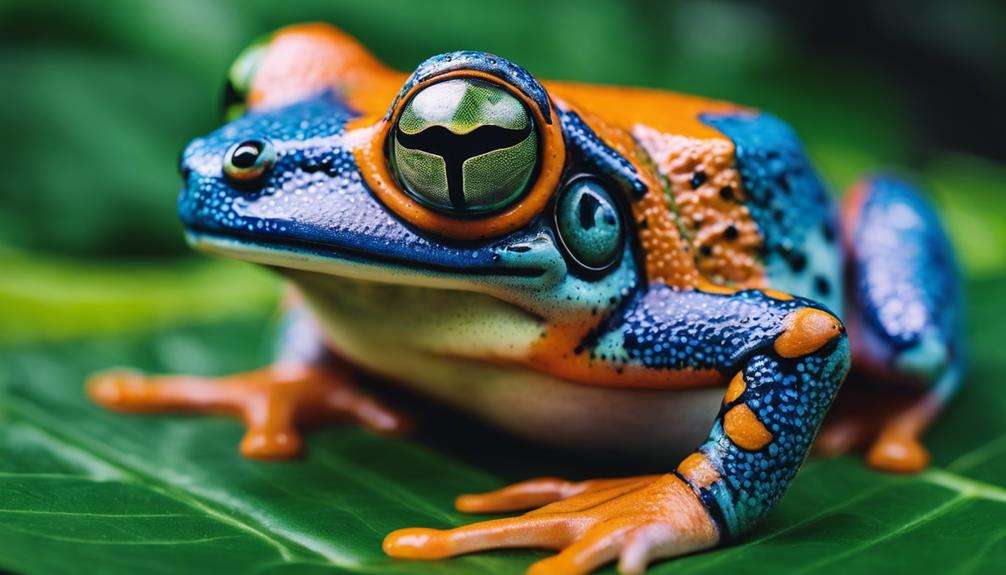
The Mexican Dumpy Frog, known for its distinctive blue-green body, tan underside, and dark eyes, is a captivating amphibian species with a lifespan of up to 20 years in captivity. These tree dwelling amphibians exhibit unique coloration patterns that make them stand out in any collection.
Here are some fascinating facts about Mexican Dumpy Frogs:
- Mexican Dumpy Frogs can grow up to 4 inches long, showcasing a compact yet striking appearance.
- Their longevity in captivity, reaching up to 20 years, allows for long-term companionship with these enchanting creatures.
- The reproduction of Mexican Dumpy Frogs involves a remarkable process where their tadpoles fall into water from the safety of foliage, highlighting their adaptation to arboreal habitats.
Observing Mexican Dumpy Frogs in their tree-dwelling environment can provide a glimpse into the intriguing behaviors and characteristics of these captivating amphibians. With their vibrant coloration and extended lifespan, these frogs offer a unique and long-lasting addition to any amphibian enthusiast's home.
Borneo Eared Frog
You'll notice the Borneo Eared Frog's striking bronze to tan coloration, accentuated by darker markings across its body.
Measuring between 2.5-3.5 inches, these small amphibians sport unique ear structures located behind their eyes.
Their arboreal preference showcases a captivating aspect of their behavior and habitat choices.
Colorful Appearance Description
Featuring a bronze to tan coloration with darker markings, the Borneo Eared Frog showcases a visually striking appearance that aids in its arboreal lifestyle and natural camouflage. This vibrant coloration allows them to blend seamlessly into their natural habitats, making them less vulnerable to predators.
The unique physical features of these frogs, including their distinctive ears located behind their eyes, are perfectly suited for their arboreal lifestyle, enabling them to navigate the treetops with ease. Their camouflage adaptations, coupled with their longevity in the wild of over 5 years, highlight the remarkable survival strategies that have evolved in these fascinating amphibians.
Habitat and Behavior Insights
Nestled among the lush canopy of Borneo's tropical forests, the Borneo Eared Frog demonstrates intricate behaviors and habitat preferences that contribute to its remarkable survival in the wild.
This species exhibits tree dwelling adaptations, utilizing its long, slender limbs and sticky toe pads to navigate the arboreal landscape with ease.
The Borneo Eared Frog is primarily nocturnal, becoming active at night to forage for small insects and other prey. Its arboreal lifestyle allows it to evade predators and access food sources efficiently.
Care Tips and Requirements
Observing the Borneo Eared Frog in its natural habitat reveals specific care tips and requirements essential for maintaining its well-being in captivity.
- Feeding tips: Provide a varied diet of insects such as crickets, flies, and mealworms to mimic their natural feeding behavior.
- Lighting requirements, humidity levels: Mimic the natural day-night cycle with 12 hours of light and 12 hours of darkness. Maintain humidity levels between 60-80% to ensure proper skin hydration.
- Handling techniques, health monitoring: Minimize handling to reduce stress, and always wash hands before and after. Regularly monitor their skin for any signs of infection or shedding issues to ensure their health and well-being.
Dyeing Dart Frog
The Dyeing Dart Frog, renowned for its vibrant appearance and toxic skin secretion, originates from Brazil and thrives in the lush rainforest habitats of Central and South America. This species captivates with its vivid toxicity, showcasing a tropical allure that highlights its poisonous beauty. Sporting a colorful and striking skin, ranging from bright yellows and oranges to vibrant blues and greens, this frog serves as a warning sign to predators due to its toxic nature.
With a lifespan of around 5 years, the Dyeing Dart Frog primarily feeds on insects found in its natural habitat. Its unique coloration and toxic skin secretion not only deter predators but also make it a fascinating amphibian species to observe. The bold patterns and hues exhibited by these frogs add a mesmerizing touch to the rainforest environment where they reside. Their poisonous beauty and striking appearance contribute to the allure of these captivating amphibians.
Phantasmal Poison Frog
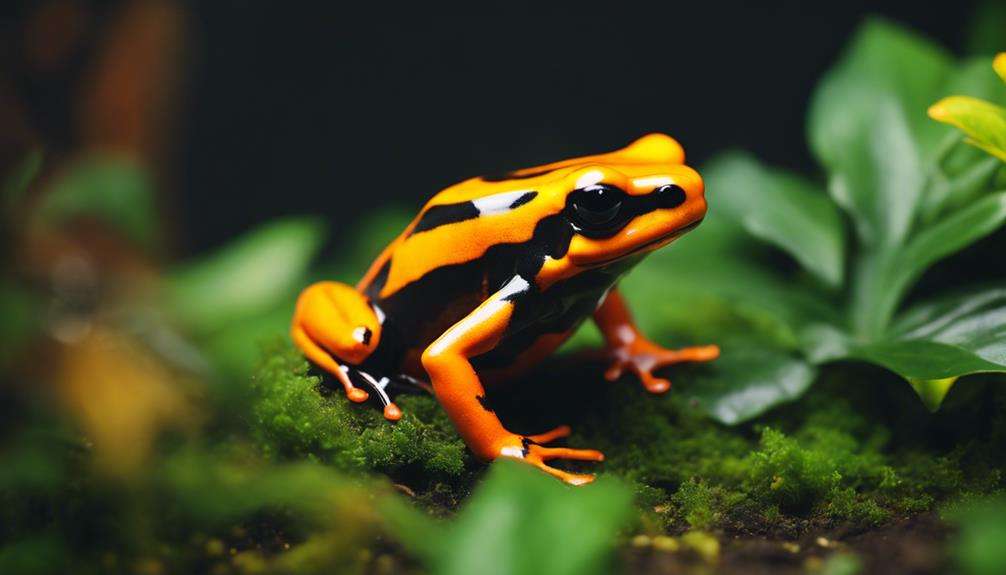
Originating from the vibrant Ecuadorian forests, the Phantasmal Poison Frog captivates with its striking red hue and intricate milky white markings, standing less than an inch in size. This tiny amphibian holds a world of wonder within its petite frame.
- Vivid Toxicity: The Phantasmal Poison Frog obtains its potent poison from the insects it consumes, showcasing its vivid toxicity as a defense mechanism against predators.
- Tiny Predators: Despite its diminutive size, this frog proves to be a formidable presence in its habitat, warding off potential threats with its toxic skin secretions.
- Ecuadorian Longevity: Found in the lush Ecuadorian forests, this species can thrive for up to 15 years in captivity, highlighting its impressive longevity in the right conditions.
The vibrant red coloration and intricate markings of the Phantasmal Poison Frog not only serve as a visual delight but also act as a warning sign to predators, cautioning them of the lethal consequences of any attempted predation.
Lovely Poison Frog
With its captivating black body adorned by thin yellow stripes and dark eyes, the Lovely Poison Frog is a visually striking amphibian native to regions in Costa Rica, Nicaragua, and Panama. This species showcases unique coloration, with its striking appearance and distinctive markings setting it apart. Despite its diminutive size of less than an inch, the Lovely Poison Frog exudes a captivating charm that can enhance any collection of amphibians.
One remarkable aspect of the Lovely Poison Frog is its long lifespan, which can extend over 15 years in captivity. This longevity makes it a valuable addition to amphibian enthusiasts looking for a long-term companion. The frog's habitat preferences in the lush regions of Central America further highlight its adaptability and resilience in various environments.
Frequently Asked Questions
What Is the Most Colorful Frog Species?
The Blue Poison Dart Frog from Suriname stands out as the most colorful frog species with its rainbow hues and vibrant patterns. Its unique adaptations include stunning coloration and camouflage techniques that mesmerize and protect it.
What Amphibians Change Color?
Amphibians change color through chameleonic abilities influenced by environmental triggers. Chromatophores control this phenomenon. Unique camouflage techniques help species like the Vietnamese Mossy Frog blend in for protection. Witness their color transformations in awe.
Why Is the Poison Dart Frog so Colorful?
Poison Dart Frogs are colorful due to an evolutionary advantage. Their vibrant hues act as warning signals to predators about their toxicity. These colors also aid in camouflage techniques, helping them blend into or stand out in their habitats.
What Is the Cutest Amphibian?
You can't help but smile at the sight of charming tree frogs. Their vibrant colors and captivating behaviors make them the cutest amphibians to grace the Earth. Observing these precious newts is a delightful experience.
Conclusion
Step into a world of vibrant beauty with these colorful amphibians adorning your home. Like living jewels, they bring a splash of nature's brilliance into your living space, creating a mesmerizing and lively atmosphere.
From the dazzling hues of the Poison Dart Frogs to the captivating markings of the Red-Eyed Tree Frogs, each species adds a unique touch of color and charm. Let these colorful creatures brighten your home and captivate your senses with their stunning presence.
